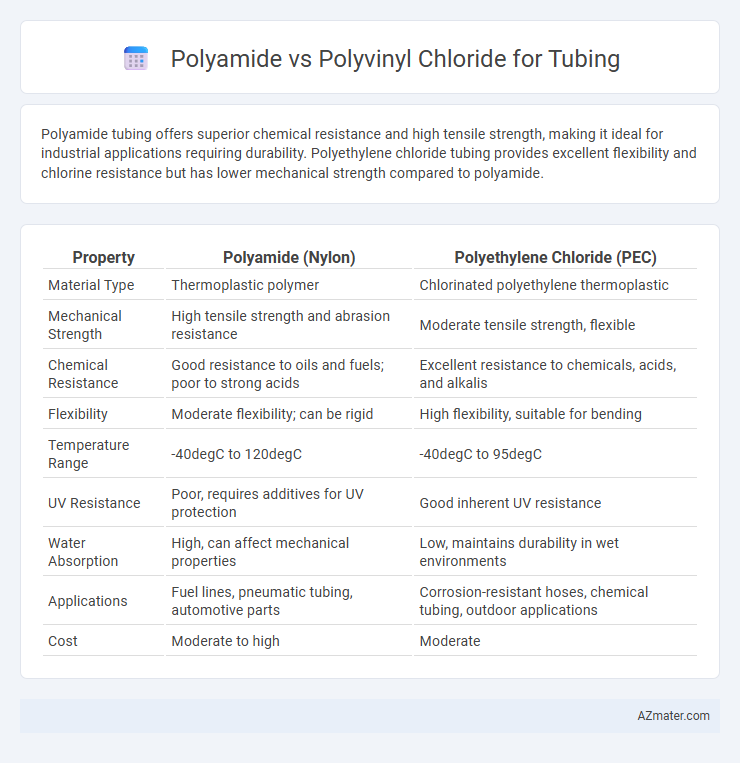Polyamide tubing offers superior chemical resistance and high tensile strength, making it ideal for industrial applications requiring durability. Polyethylene chloride tubing provides excellent flexibility and chlorine resistance but has lower mechanical strength compared to polyamide.
Table of Comparison
| Property | Polyamide (Nylon) | Polyethylene Chloride (PEC) |
|---|---|---|
| Material Type | Thermoplastic polymer | Chlorinated polyethylene thermoplastic |
| Mechanical Strength | High tensile strength and abrasion resistance | Moderate tensile strength, flexible |
| Chemical Resistance | Good resistance to oils and fuels; poor to strong acids | Excellent resistance to chemicals, acids, and alkalis |
| Flexibility | Moderate flexibility; can be rigid | High flexibility, suitable for bending |
| Temperature Range | -40degC to 120degC | -40degC to 95degC |
| UV Resistance | Poor, requires additives for UV protection | Good inherent UV resistance |
| Water Absorption | High, can affect mechanical properties | Low, maintains durability in wet environments |
| Applications | Fuel lines, pneumatic tubing, automotive parts | Corrosion-resistant hoses, chemical tubing, outdoor applications |
| Cost | Moderate to high | Moderate |
Introduction to Polyamide and Polyethylene Chloride Tubing
Polyamide tubing offers high mechanical strength, excellent chemical resistance, and superior flexibility, making it ideal for demanding industrial and medical applications. Polyethylene chloride tubing provides outstanding clarity, good chemical resistance, and is often selected for fluid transfer systems requiring visibility and chemical compatibility. Both materials excel in durability and performance but differ significantly in applications due to their distinct physical and chemical properties.
Chemical Structure Comparison
Polyamide tubing features amide linkages (-CONH-) in its backbone, providing strong hydrogen bonding and enhanced chemical resistance, while polyethylene chloride incorporates chlorine atoms attached to polyethylene chains, increasing its polarity and resistance to oils and solvents. The presence of nitrogen in polyamides contributes to higher thermal stability and mechanical strength compared to the flexible and chemically inert nature of polyethylene chloride derived from chlorinated polyethylene units. These structural differences affect tubing performance, with polyamide offering rigidity and chemical durability, while polyethylene chloride provides flexibility and exceptional resistance to hydrocarbons and chemicals.
Mechanical Properties and Strength
Polyamide tubing exhibits higher tensile strength and better resistance to abrasion compared to polyethylene chloride, making it ideal for applications requiring durability under mechanical stress. Polyethylene chloride offers superior flexibility and chemical resistance but has lower impact strength and tensile modulus than polyamide. Choosing between these materials depends on the balance of mechanical performance and chemical exposure in the tubing's intended use.
Flexibility and Bend Radius
Polyamide tubing offers superior flexibility with a smaller bend radius, making it ideal for applications requiring tight turns and dynamic movement. Polyethylene Chloride tubing, while chemically resistant, exhibits a larger bend radius and is less flexible, which can limit its use in compact or intricate routing setups. Selecting polyamide over polyethylene chloride improves performance in environments demanding enhanced flexibility and tight bending capabilities.
Chemical Resistance and Compatibility
Polyamide tubing offers superior chemical resistance to oils, fuels, and hydrocarbons, making it ideal for automotive and industrial applications where durability is critical. Polyethylene chloride (PEC) tubing provides excellent resistance to acids, bases, and many solvents, enhancing compatibility with aggressive chemicals commonly used in laboratory and pharmaceutical environments. Choosing between polyamide and polyethylene chloride tubing depends on specific chemical exposure, with polyamide preferred for hydrocarbons and PEC favored for corrosive substances.
Temperature Tolerance and Thermal Stability
Polyamide tubing offers superior temperature tolerance, typically withstanding continuous use temperatures up to 120degC, while polyethylene chloride generally handles lower temperatures around 60degC to 80degC. Polyamide's thermal stability ensures minimal deformation and extended lifespan under fluctuating heat conditions, making it ideal for applications requiring heat resistance. In contrast, polyethylene chloride exhibits less thermal stability, prone to softening and reduced mechanical strength at elevated temperatures.
Applications in Various Industries
Polyamide tubing offers excellent chemical resistance and high temperature tolerance, making it ideal for automotive fuel lines, medical devices, and pneumatic systems. Polyethylene chloride tubing provides superior flexibility and moisture barrier properties, widely used in food packaging, pharmaceutical packaging, and water treatment industries. Selecting between polyamide and polyethylene chloride depends on specific application requirements such as durability, chemical exposure, and temperature stability.
Cost Considerations and Availability
Polyamide tubing generally incurs higher costs due to its superior durability and chemical resistance, making it suitable for specialized industrial applications. Polyethylene chloride, being more affordable and widely produced, offers cost-effective availability for general-purpose tubing needs. Availability of polyamide is more limited, often requiring longer lead times compared to the readily accessible polyethylene chloride tubing in standard sizes.
Environmental Impact and Recyclability
Polyamide tubing offers durability and chemical resistance but has a more complex recycling process, often requiring specialized facilities due to its polymer structure. Polyethylene chloride, commonly known as PVC, poses environmental concerns due to the release of harmful dioxins during incineration and challenges in recycling because of its chlorine content. Both materials impact the environment differently, with polyethylene chloride generally considered less eco-friendly, while advances in recycling technologies continue to improve polyamide's sustainability profile.
Choosing the Right Tubing Material
Polyamide tubing offers excellent chemical resistance and high tensile strength, making it ideal for applications requiring durability and flexibility under pressure. Polyethylene chloride provides superior resistance to abrasion and is highly resistant to many solvents, best suited for environments with aggressive chemicals or rough handling. Selecting between polyamide and polyethylene chloride tubing depends on the specific demands of temperature, chemical exposure, and mechanical stress in your application.

Infographic: Polyamide vs Polyethylene Chloride for Tubing
 azmater.com
azmater.com